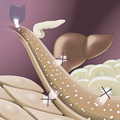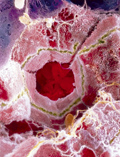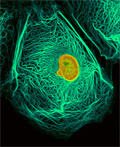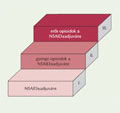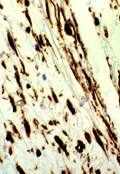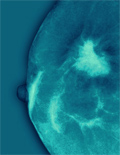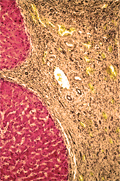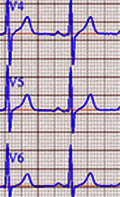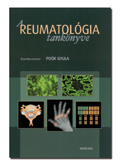The eLitMed.hu medical portal uses computer cookies for convenient operation. Detailed information can be found in the Cookie-policy.
Lege Artis Medicinae - 2008;18(11)
Content
[DISEASES OF THE EXOCRINE PANCREAS AND DIABETES MELLITUS]
[Exocrine and endocrine pancreas constitutes close anatomical and functional links accordingly, any disease affecting one of these sectors will inevitably affect the other. Acute and chronic pancreatitis, pancreatic surgery, cystic fibrosis and pancreatic cancer are those pancreatic conditions that might cause diabetes mellitus. The development of diabetes greatly influences the prognosis and quality of life of patients with exocrine pancreatic diseases. The lack of glucagon and the impaired absorption of nutrients may cause life-threatening complications, such as hypoglycaemia, and the micro- and macrovascular complications may impair the organ functions. Diabetes mellitus is an independent risk factor of mortality in those with exocrine pancreatic diseases. Pancreatic diabetes is a distinct metabolic and clinical form of diabetes, requires special treatment. Diet and pancreatic enzyme replacement therapy may be sufficient in the early stages. Oral antidiabetic drugs are not recommended. If the diet proves inadequate to reach the glycaemic goals, regular insulin treatment is demanded. There are special impairments of the exocrine function and the pancreatic morphology at diabetic patients that resemble to chronic pancreatitis. Atrophy of the exocrine tissue may caused by the lack of trophic insulin. Hyperglycaemia can activate the stellate cells that lead to pancreatic fibrosis. The microangiopathy and neuropathy, as well as the lack of islet hormone action - responsible for the exocrine pancreas regulation - will cause further damage on the pancreas glandular tissue. In the event of a proven impairment of the pancreatic exocrine function in diabetes mellitus, pancreatic enzyme replacement therapy is recommended. This may improve the nutritional condition and decrease the metabolic instability.]
[CRITICAL SITUATIONS IN SYSTEMIC AUTOIMMUNE DISEASES]
[Systemic autoimmune diseases characteristically show multiple organ involvements. Hence, Clinical manifestations and the outcome are quite variable. The survival has continuously been improving due to more sophisticated diagnostic tools and therapeutic possibilities. Despite the technical development, complications and organ manifestations may lead to emergency or often provoke permanent functional or morphologic deterioration of the affected organs. Critical situations can be directly attributed to the manifestations of the underlying disease, deterioration of the affected organs, side effects of immune suppressive therapy complications of Intercurrent or co-incidental diseases also may induce the occurrence of critical complications. The Authors describe all conditions that may lead to the development of critical situations at systemic autoimmune disease regarding different organ and organ systems. The symptoms and diagnostic possibilities are also analysed. A checklist is given about those systemic autoimmune disorders where particular critical events can be present. Medication in general and other possible immune modulator managements with beneficial effects are discussed.]
[INCRETIN MIMETICS AND INCRETIN ENHANCERS: NEW THERAPEUTIC TOOLS IN THE TREATMENT OF PATIENTS WITH TYPE 2 DIABETES MELLITUS]
[Incretins are hormone-like peptides secreted by specific cells of the small intestine mucosa. Their two main representatives are the glucagon-likepeptide- 1 (GLP-1 and the glucose-dependent insulinotropic peptide, (GIP) the release of which is stimulated by meals. The main action of incretins is to enhance insulin secretion following meals. They are rapidly metabolized in the circulation by the enzyme dipeptidyl peptidase IV (DPP-IV). Patients with type 2 diabetes have markedly impaired incretin-mediated insulin secretion mainly due to decreased secretion of GLP-1. Research in the last years has opened up a new therapeutic option to treat patients with type 2 diabetes. Continuous intravenous use of GLP-1 cannot be widely used in clinical practice; however, GLP-1-mimetics that have an agonist effect on the receptors but are resistant to degradation by DPP-IV have been developed. The GLP-1 agonist xenatide, due to its incretin mimetic property, stimulates postprandial insulin secretion, suppresses glucagon secretion, delays gastric emptying and increases sense of fullness thus resulting in weight reduction. In experimental settings, exenatide has a documented beta-cell protecting property. Its disadvantages include the fact that it can only be administered subcutaneously and that it has a well characterized side effect profile. On the contrary, the DPP-IV inhibiting incretin enhancers (sitagliptin, vildagliptin) can be used orally and are well tolerated. Exenatide, sitagliptin and vildagliptin are the first representatives of incretin mimetics and incretin enhancers. Sitagliptin has been available in Hungary since August, 2008. Their effect to reduce blood glucose and HbA1c should mainly be exploited in combination therapy, preferably with metformin. The availability of incretin mimetics and incretin enhancers will offer new therapeutic options for treating patients with type 2 diabetes. Nevertheless, the final assessment of these new drugs will require long-term experience in the clinical practice.]
[UP-TO-DATE MANAGEMENT OF CHRONIC HEPATITIS B]
[Hepatitis B virus infection is a significant health problem worldwide, as well as in Hungary. The chronic infection is usually symptomless, its most dangerous risks are liver cirrhosis and hepatocellular carcinoma. The latter may occur without development of liver cirrhosis, so it means a potential complication for patients with inactive phase of infection, as well. Criteria of the indication of antiviral treatment have changed in the last years due to the flare of our knowledge about the natural history of the disease. In our days quantitative determination of hepatitis B viral nucleic acid titer is essential for diagnosis. Formerly, a HBsAg positive patient with normal liver enzymes had been regarded as inactive carrier, and antiviral treatment had not been advised. In our days, the phase of the infection and the necessity of the treatment can not be determined without measurement of nucleic acid titer. Liver biopsy and, if inflammation or fibrosis is present, antiviral treatment is indicated, if the nucleic acid titer is >20 000 IU/ml in HBeAg positive, and >2000 IU/ml in HBe negative cases, respectively. Interferon alpha is the gold standard of treatment for chronic B hepatitis. Pegylated interferon alpha-2a is used because of its better pharmacokinetic properties. Oral agents include nucleoside/ nucleotide analogues with rare and mild adverse effects, and they may be given to patients with decompensated liver disease. Their main disadvantages include the development of drug-resistance, and the very low ratio of HBsAg-anti-HBs seroconversion. Recent drugs like adefovir, entecavir and tenofovir have replaced lamivudin, which has been in use for the longest time, because they are more effective and resistance against them is less frequent.]
[CHANGING STRATEGY IN THE LONG-TERM TREATMENT OF OVARIAN CANCER - ON THE IMPORTANCE OF PLATINUM-FREE INTERVAL]
[It was during the last 15 years when justified by clinical studies the sensitivity/resistance to anticancer chemotherapy was included in the setting of the prognostic factors of the ovarian cancer, while demonstrating a stronger correlation with the outcome than those factors known before. Remission and duration of remission after first-line chemotherapy are the two important components of sensitivity and their combinations measure its grade in a semi-quantitative manner. The chemotherapy sensitivity/resistance approach is based on the observations on ovarian cancer patients treated with platinum based chemotherapy. This agent in repeated adminstrations during the whole course of the disease is still a decisive component of the ovarian cancer chemotherapy. As a consequence there is always “a platinum-free interval”. The prolongation of this platinum-free interval with non-platinum chemotherapy has the potencial of increasing the remission and survival by platinum reinduction administered in the third-line of chemotherapy. In spite of the facts mentioned above, there are centers which prefer the early re-administration of taxan/platinum combination to the prolongation of platinum- free interval and expose their patients to an elevated risk of cumulative, in the first-line non-haematological toxicity.The neurotoxicity can deteriorate the quality of life and the parenchymal laesion of kidneys can prevent further chemotherpy.]
[OPTIMIZATION OF PAIN THERAPY BASED ON PHARMACOKINETICS - INNOVATIVE DRUG DELIVERY SYSTEMS]
[Medicinal preparations with durable analgetic effect are essential for therapy of the chronic pain. Controlling drug release allows the influence of fate of drug in the body as well as prolongation of duration of action. Development of innovative dosage forms as drug delivery systems offers increased efficacy and tolerability to improve patient's quality of life. Beside maintaining continuous therapeutical effect, extended drug release allows the spacing of dosing frequency. In addition, the more advantageous dosage regimen may improve the patient compliance during drug therapy. The review focuses on the aspects required to design drug carrier systems with original pharmacokinetic profile based on special pharmaceutical technological methods in order to optimize drug therapy for pain management.]
[LOW GRADE FIBROMYXOID SARCOMA OF THE TEMPORALIS MUSCLE - A CASE REPORT]
[INTRODUCTION - Low grade fibromyxoid sarcomas (LGFMS) in most cases arise in the skeletal muscle primarily in young to middleaged adults. Males are affected more commonly than females. The tumour tipically arises in the lower extremities, particularly the thigh. Hyalinizing spindle cell tumor with giant rosettes is a variant of LGFMS that demonstrates a significant overlap with classic LGFMS regarding patient age and tumor location, histological appearance and metastatic potential. CASE REPORT - A 76 year-old male presented with a ten-year history of a painless, slowgrowing, hard consistency, left-sided temporal mass. The radiological differential diagnosis included liposarcoma, malignant fibrous histiocytoma and rhabdomyosarcoma. Histopathological examination revealed low grade fibromyxoid sarcoma featuring low cellularity, collagenized areas and alternating myxoid areas, and a focal whorling pattern of tumour cells that were immunoreactive for vimentin, but were negative for S100, CD34, muscle specific actin, desmin and cytokeratin (AE1/AE3). CONCLUSIONS - To the best of our knowledge, this is the first report of low grade fibromyxoid sarcoma involving the temporalis muscle.]
1.
Clinical Neuroscience
[Headache registry in Szeged: Experiences regarding to migraine patients]2.
Clinical Neuroscience
[The new target population of stroke awareness campaign: Kindergarten students ]3.
Clinical Neuroscience
Is there any difference in mortality rates of atrial fibrillation detected before or after ischemic stroke?4.
Clinical Neuroscience
Factors influencing the level of stigma in Parkinson’s disease in western Turkey5.
Clinical Neuroscience
[The effects of demographic and clinical factors on the severity of poststroke aphasia]1.
2.
Clinical Oncology
[Pancreatic cancer: ESMO Clinical Practice Guideline for diagnosis, treatment and follow-up]3.
Clinical Oncology
[Pharmacovigilance landscape – Lessons from the past and opportunities for future]4.
5.






